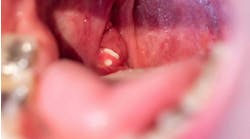In a conversation with a good friend, ideas bounce around as the conversation moves in unexpected directions or into uncharted territories. A recent conversation with a colleague from Pierce College in Lakewood, Wash., revealed some exciting news about a special collaboration between the college's dental hygiene students and those studying to become fitness trainers.
The genesis of the collaboration began with a dialogue between several faculty members from the two academic programs. The dental hygiene faculty at Pierce College believes that health-care professionals should model healthy behaviors. The faculty feels personal well-being improves our credibility when we provide health advice to patients. Recently, Pierce College added a fitness trainer program; those students graduate with a certificate in health and fitness technology.
At the beginning of a recent semester, the fitness students were invited to visit the dental hygiene clinic, which is housed in a neighboring building. The fitness students observed the dental hygiene students' postures and ergonomic challenges. They evaluated their peers in dental hygiene and created a customized fitness plan for each dental hygiene student, taking into account individual personal goals such as weight loss, muscular toning, or stress reduction.
Each dental hygiene student received a customized exercise plan developed by their fitness student partner, with a focus on strength, endurance, and flexibility. Then the fitness students taught their specific dental hygiene partners the customized exercise plan at the college's fitness center. Throughout the year, friendships between the two student groups grew, and the student pairs often spent time working out together.
The fitness trainer and dental hygiene partnership at Pierce College is a novel concept, a perfect example of how creative minds can put their thoughts together and come up with a unique approach to an obvious set of problems. Dental hygiene practice is demanding.1 Arming students with a customized plan to improve health and core strength is a wonderful foundation for preventing needless occupational injuries. Stay tuned for more information about how this exciting program is helping dental hygienists become better role models.
Dental hygienists are prevention specialists, but often our thoughts and actions focus outward, forgetting or diminishing our own physical and emotional needs. Work stress, poor equipment, static postures, insufficient rest, and lack of exercise compound the situation.2-5 Many of us are looking for ways to get healthier and reduce the daily aches and pains that plague so many of us in clinical practice.6
Given the rising rates of obesity in this country and the increase in related conditions such as diabetes and hypertension, health-care providers need to take a leadership role in developing and modeling healthier lifestyles.2,7 While there are many ways to achieve better health, three resources have proven to be outstanding sources of information for dental professionals.
Over a decade ago, Pete Egoscue, an anatomical physiologist, wrote a book called "Pain Free: A Revolutionary Method for Stopping Chronic Pain." The book contains a plethora of exercises that focus on treating chronic workplace musculoskeletal pain. Hygienists such as Karen Stueve from Minster, Ohio, have committed to this program. Over time, Karen was able to significantly reduce her chronic neck pain. Karen has taken her interest a step further and obtained certification from Egoscue University as a posture alignment specialist to help people get relief from chronic pain.
Bethany Valachi, PT, MS, is a physical therapist with a special interest in helping dental professionals. Not only has she authored a book called "Practice Dentistry Pain-Free: Evidence-based Strategies to Prevent Pain and Extend your Career," she has also developed a series of videos that include specific exercises for us. "Smart moves on the ball" and "Smart moves chairside stretching and trigger point therapy" are both available through her Web site, www.posturedontics.com.
As Pilates began to grow in popularity, certified Pilates instructor Juli Kagan, RDH, MS, saw a need for a Pilates program targeted to the needs of the seated professional. Juli's passion for health and fitness resulted in the publication of her book, "Mind Your Body: Pilates for the Seated Professional" in 2007. Her Web site also contains a number of short videos demonstrating exercises that we can all put to good use. Juli's fitness philosophy is summed up by the following mantra: Sit tall. Stand strong. Work without pain.
On occasion, creative, adventurous minds come up with new and innovative ideas that can help us improve our comfort zone.
References1. Yamalik N. Musculoskeletal disorders (MSDs) and dental practice Part 2. Risk factors for dentistry, magnitude of the problem, prevention, and dental ergonomics. Int Dent J. 2007 Feb; 57(1):45-54.2. Hamberg-van Reenen HH, van der Beek AJ et al. Age-related differences in muscular capacity among workers. Int Arch Occup Environ Health. 2009 Mar 1.3. Novak CB. Upper extremity work-related musculoskeletal disorders: a treatment perspective. J Orthop Sports Phys Ther. 2004 Oct; 34(10):628-37.4. Mani L, Gerr F. Work-related upper extremity musculoskeletal disorders. Prim Care. 2000 Dec; 27(4):845-64.5. Mäntyselkä P, Kautiainen H, Vanhala M. Prevalence of neck pain in subjects with metabolic syndrome--a cross-sectional population-based study. BMC Musculoskelet Disord. 2010 Jul 30; 11:171.6. Hildebrandt VH, Bongers PM et al. The relationship between leisure time, physical activities and musculoskeletal symptoms and disability in worker populations. Int Arch Occup Environ Health. 2000 Nov; 73(8):507-18.7. Miranda H, Viikari-Juntura E et al. A prospective study of work related factors and physical exercise as predictors of shoulder pain. Occup Environ Med. 2001 Aug; 58(8):528-34.8. Holth HS, Werpen HK et al. Physical inactivity is associated with chronic musculoskeletal complaints 11 years later: results from the Nord-Trøndelag Health Study. BMC Musculoskelet Disord. 2008 Dec 1; 9:159. Anne Nugent Guignon, RDH, MPH, provides popular programs, including topics on biofilms, power driven scaling, ergonomics, hypersensitivity, and remineralization. Recipient of the 2004 Mentor of the Year Award and the 2009 ADHA Irene Newman Award, Anne has practiced clinical dental hygiene in Houston since 1971.





